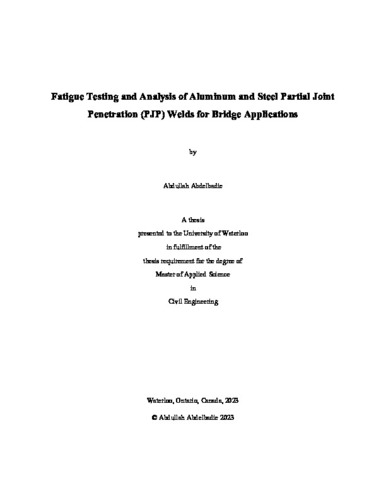| dc.contributor.author | ABDELBADIE, ABDULLAH | |
| dc.date.accessioned | 2023-05-30 14:30:50 (GMT) | |
| dc.date.available | 2023-09-28 04:50:05 (GMT) | |
| dc.date.issued | 2023-05-30 | |
| dc.date.submitted | 2023-05-03 | |
| dc.identifier.uri | http://hdl.handle.net/10012/19508 | |
| dc.description.abstract | Partial joint penetration (PJP) welds are a cost-effective alternative to full penetration welds and have certain advantages, especially in situations where a full penetration weld is unnecessary and the stress on the weld is low. Unfortunately, these welds are typically fatigue prone, and determining the fatigue stress limit for PJP welds, and similarly for aluminum partial penetration flare bevel groove (FBG) welds, is challenging because the available methods are either untested in these applications or overly complex. PJP welds are also useful in situations where full penetration welds are impractical, such as in thin components like rib-deck welds of orthotropic steel decks (OSDs) where weld defects can result if a full penetration weld is attempted. Current provisions in CSA S6-19 Clause 10.16 require the design of OSDs to satisfy the requirements of Clause 9.8.3 of AASHTO LRFD Bridge Design Specifications while still using loads and factors from CSA S6-19 for the fatigue limit state (FLS). Due to the difference in applied factors and loads, there are instances when attempting to use this approach incorrectly can lead to possible negative outcomes from the point of view of structural safety or economy. For example, in the fatigue design, it is not clear when to switch from the AASHTO provisions (for analysis) to the CSA provisions (to account for the Canadian truck traffic). This issue raises serious concerns, which may discourage designers in Canada from employing OSD solutions and thus harnessing their benefits in new bridge projects and applications involving service life extension of existing bridges.
Against this background, a study was conducted to address current gaps in the literature concerning the fatigue performance of PJP and partial penetration FBG welds in bridge applications.
The experimental fatigue testing of 19 T-joint aluminum FBG welded specimens, conducted within the scope of this study, yielded valuable insights into the fatigue behavior of these components. Notably, the effective throat was found to be the most important factor influencing the performance of FBG welds, and it was found that precision in the welding execution is crucial. An SN curve was established based on the experimental results for a 95% survival probability. The weld performance based on the design curve was found to be similar to Detail Category E in CSA S6-19. Linear elastic fracture mechanics (LEFM) methods were then used, along with a 3D finite element (FE) model, to supplement the experimental study and predict the fatigue performance of the tested aluminum FBG welds.
Lastly, an investigation was conducted on OSD rib-deck welds to determine how the transverse wheel location affects the stress at the root and toe. In order to address the ambiguity issues identified in CSA S6-19, the local stresses resulting from Canadian and American trucks were computed and compared to demonstrate the correct use of the appropriate factors required for fatigue design. | en |
| dc.language.iso | en | en |
| dc.publisher | University of Waterloo | en |
| dc.subject | linear elastic fracture mechanics | en |
| dc.subject | hotspot stress method | en |
| dc.subject | partial joint penetration welds | en |
| dc.subject | fatigue | en |
| dc.subject | aluminum flare bevel groove welds | en |
| dc.subject | orthotropic steel decks | en |
| dc.title | Fatigue Testing and Analysis of Aluminum and Steel Partial Joint Penetration (PJP) Welds for Bridge Applications | en |
| dc.type | Master Thesis | en |
| dc.pending | false | |
| uws-etd.degree.department | Civil and Environmental Engineering | en |
| uws-etd.degree.discipline | Civil Engineering | en |
| uws-etd.degree.grantor | University of Waterloo | en |
| uws-etd.degree | Master of Applied Science | en |
| uws-etd.embargo.terms | 4 months | en |
| uws.contributor.advisor | Walbridge, Scott | |
| uws.contributor.affiliation1 | Faculty of Engineering | en |
| uws.published.city | Waterloo | en |
| uws.published.country | Canada | en |
| uws.published.province | Ontario | en |
| uws.typeOfResource | Text | en |
| uws.peerReviewStatus | Unreviewed | en |
| uws.scholarLevel | Graduate | en |

